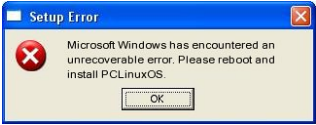| Previous
Page |
PCLinuxOS
Magazine |
PCLinuxOS |
Article List |
Disclaimer |
Next Page |
Mind Your Step: Going On Sabbatical |
|
by phorneker It has been quite a while since my last article, and quite a few things have happened. I have reassessed my online assets, and have made a decision to move my original website to Neocities. This leaves a lot of space open to develop the Horneker Online brand into something bigger.  GoDaddy currently provides 100GB of space on a server running CentOS 6. (I found this out by accessing the site through SSH and typing uname -a on the command line. I could install WordPress, Drupal or Joomla into this space. But then, being that these are popular applications for website development, that leads to questions about the security of those applications, specifically the vulnerability of the products to cybercriminal attacks. If there is one thing I have learned from reading about such attacks is that most of these attacks affect products that are popular in the mainstream markets for information technology. What do Android powered smartphones, Apple iPhones, Mac OS-X and Windows 10 have in common? They are mainstream products that are widely available and widely used. The same is true with WordPress, Drupal and Joomla. Cybercriminals will spend time on these products because they are widely used and are popular. Have you noticed that no virus, trojan horse or other malware has ever successfully run on ArcaOS or any of its OS/2 predecessors? If you have watched videos about Linux on YouTube, especially ones that compare various distributions, did you notice that most of those videos do not even mention PCLinuxOS. It does not do us well when it comes to public exposure of the distribution. But in this case, it is a good thing. Sometimes, not being popular has its benefits. What I am saying is that the less popular a technology or product is, the less likely cybercriminals will spend time trying whatever it is they do on these products. (...and who doesn't want that?)  I am considering installing Nextcloud on my webspace after moving the original website to Neocities. So far, It seems to work, but with a few quirks. The webspace assigned contains 100GB of storage and runs in a container configured with 512MB of RAM, and enough bandwidth for a low traffic website, which this website has been for the past 24 years! I have not decided whether to go for it or not, being that this is a low traffic website, and that Nextcloud was designed for high traffic servers. What attracts me to this solution is the high level of security built into the application. The fact that this website existed for 24 years without a data breach or other attack is proof that the less popular a technology, product or idea is, the less it becomes vulnerable (or even feasible) to cyberattacks. Case in point, the Slackware website is still accessed through HTTP instead of HTTPS, due to the fact that almost no one new to Linux has even heard of Slackware, let alone trying to install that distribution on their machines. At least my website is accessed only through HTTPS, which is important as I do not want my website to be tagged as Not Secure by Google simply because I did not enable HTTPS for my website.  Another solution I am considering is to use a product such as WordPress, but not allowing any accounts to be created. (The main website for PCLinuxOS does just that!) I know that I just mentioned that WordPress is a popular product for building websites. But the way it is used on the main PCLinuxOS website is an exception to that theory. My current website uses an adaptation of the Spectre theme available at HTML5 UP! Website. I have experimented with different themes available on the Internet. At the end of the day, I end up going back to the same Spectre theme. What this site really needs is some new content. Up to now, the content that could have been provided for this website has been published in this magazine. The only thing I could do is to add links to the article in the magazine on my website. Meanwhile, I could look into what is available at GoDaddy to install on my website, keeping security in mind (i.e. I do not want any algorithms or malware coming into my website. This is the way this website has been designed and developed for 24 years, and I intend to keep it that way.) The other thing I did was to replace the current hard drive with a 480GB SanDisk Solid State Drive. Considering the age of the laptop (14 years), the SATA controller did indeed support the new SSD and PCLinuxOS installed without any issues. The only thing I have to do every so often is to run fstrim -va every so often to ensure the SSD will work properly. So far, the overall performance of PCLinuxOS on this 14 year old laptop is nothing short of outstanding. Of course, this also means that I had to rethink what should be installed on this laptop. For example, I have LibreOffice, Apache OpenOffice.org, and SoftMaker Office installed. The latter is a commercial product. But then, so are Google Chrome and Microsoft Edge, both of which are available in the PCLinuxOS repository. SoftMaker Office is for gaining experience with the latest versions of Microsoft Office. The ribbon interface came in really handy when I took assessment tests for Microsoft Word on Indeed.com. (If you want to work for a company that relies on Microsoft products, you will need to have this experience.) Apache OpenOffice.org may be ancient when compared to LibreOffice. However, it works the same today as it did ten years ago. If you have a machine that is 20 years old and is still running Windows XP, Solaris, or an old version of Linux, chances are, it is running either StarOffice, or OpenOffice.org. Also, there is no version of LibreOffice that runs on ArcaOS (or earlier versions of OS/2). However, OpenOffice.org is available for ArcaOS from that company's software repository, as well as a stand alone binary compiled for OS/2. You never know when you need to backport a document for use with an older (vintage) computer. For these reasons, I shall be going away for some time before my next article. But, before I do... Social Media News  Normally I would criticize social media for various things, particularly regarding privacy and confidentiality of personal data. But this time, I am praising Twitter for what should have been done some time ago with some of the accounts of key players in the current administration. On November 7, CNN reported that Twitter permanently closed Steve Bannon's Twitter account for suggesting the beheading of Dr. Anthony Fausi and Christopher Rey. This does not need any real explanation here as to why this Twitter account has been shut down. First of all, the First Amendment, while it guarantees free speech, does not cover speech that incites violence or rioting (How many of you actually knew that?) Second, such statements violate the Terms of Service for most social media accounts, among other Internet services involving user generated content. In addition, the video posted on Bannon's Facebook account was removed. That video also violated the Terms of Service, this time for Facebook. It does not matter who you are (or think you are), when you use a service such as Twitter or Facebook, you must abide by their rules as you are using their network to post your thoughts and ideas. Yes, I do believe in the First Amendment. I also believe there is such a thing as proper decorum, and inciting violence violates both the First Amendment and proper decorum. I also believe that as this matter develops, what happens on social media is going to get very UGLY!!! Perhaps, about as ugly as the 2000-2003 case of MPIAA vs the developers of WinDVD over the right to play DVDs on your computer. When all is said and done (hopefully before this year is out), there will have to be some kind of regulation placed on social media, especially the same type of regulation that once was placed on newspapers, television and radio. ...and so far, Twitter made the right move with this first step. (It would also be a good idea to read the Terms of Service next time you log in to a social media account.) Disturbing Linux Trends   One trend in Linux I have noticed recently is the concept of the immutable distribution. So far, the Fedora Project (sponsored by Red Hat/IBM) has the Silverblue distribution, and openSuSE has MicroOS. These distributions are small in ISO size (about 100 to 200 megabytes), and as the name suggests, they are immutable, i.e. you cannot change anything in the base distribution. On one hand, this is a safe way to (quickly) deploy desktops en masse. On the downside, software management is no different from that of a smartphone, and given the state of cybersecurity we have, this is a very dangerous concept. For both Silverblue and MicroOS, applications are installed from Flatpaks, i.e. downloaded from Flathub. Beyond that, almost nothing else is supported when it comes to software installation. PCLinuxOS does support Flatpaks, which supplements the application library available, instead of replacing the application library as these distributions do. Immutable distributions are ideal for large corporate environments where desktop usage needs to be tightly controlled, and these distributions do just that. Every desktop running these immutable distributions on a given network looks and works exactly alike from one desktop to the next in that network. (They are also useful for installing Linux on machines which will never be connected to the Internet, in which case, no updates could possibly be available due to the lack of network connectivity.) The system administrator or another employee in that network's information technology department decides what goes on the end user's desktop, and once the workstation image has been built, all that needs to be done to deploy a workstation is to install that image on that workstation. For us, who are used to using PCLinuxOS, we are very thankful we will not be going in this direction. This reminds me of Windows 95, in particular that infamous launch party. The clear intent of that release was to get every personal computer in the world running Windows 95, all running the same desktop, and navigating the system the same way. The concept was repeated with the Windows 8 launch and that attempt to get every device, be it a tablet, a smart phone, or a desktop computer looking and working the same way! That said, this brings up another critical issue about immutable distributions. When we first started using Linux, it was all about the freedoms we gained, i.e. freedom of choice, freedom from corporate control, and our basic freedoms we have as citizens. While immutable distributions are good for large corporate environments, they are not good for home or small business usage. That is what we have PCLinuxOS for!!!!! Besides, by giving up control over our Linux installations to the vendors and/or developers, we defeat the reason why we went to Linux in the first place. Immutable systems are nothing new, either. Acorn Computers had RISC-OS on ROM chipsets as part of their Archimedes line of home and business computers. Atari (under Jack Tramiel) included TOS on ROM chipsets in their ST, STE, TT and Falcon line of 16/32-bit machines sold in the late 1980s and early 1990s. Versions of DOS were included on ROM chipsets on Zenith's Easy-PC, and IBM's PS/1 series of (now vintage) computers designed for the consumer market. Windows Subsystem for Linux: Does it make any sense? The other thing happening in mainstream Linux is the deal made with Microsoft where Linux can be installed on a partition with Windows installed, by way of Microsoft's Windows Subsystem for Linux. This allows Linux to be installed on machines without having to create a dual-boot setup, i.e. Install Windows first on part of the hard disk, then Linux on another part of the disk. Sure you will be able to run Linux on that machine. But at the end of the day, you will still be running Windows while you are running Linux. Does this really make any sense at all? That would be similar to building an office tower from (American made) steel on the San Andreas fault. Knowing that any land on or near that fault is anything but stable enough (subject to earthquakes) to build a foundation for a building, you could build an office tower near there, but how long would it last before the next earthquake destroys that building. |





